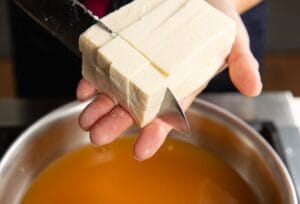Elevate your Japanese dining experience by learning what to eat with miso soup. Our best miso soup recipes will help you pair this classic dish perfectly!
There’s something magical about a steaming bowl of miso soup. As the savory aroma wafts up to greet you, it’s like getting a warm hug on a cold day. This traditional Japanese soup has brought me comfort and joy for years, and I’m excited to share the recipe and story behind this soul-soothing dish.
As a child, my family hosted Japanese exchange students who introduced me to miso soup. I was fascinated by the rich umami flavor and how something so simple could be so satisfying. The soft cubes of tofu nestled in the broth were a texture surprise in my young palate. I was hooked after the first spoonful and would request miso soup with every meal.
As an adult now living on my own, memories of miso’s mellow warmth often come to mind on difficult days. I’ll put some broth on the stove, add a few ingredients, and be transported back to happier times slurping this soup with people I love. The preparation process itself can be therapeutic – focusing on chopping the green onions, measuring the miso paste, and watching the soup transform as ingredients meld together.
I hope this miso soup recipe brings you the same feelings of nostalgia, comfort, and connection it has brought me. I encourage you to put on some relaxing music, focus on each step, and sip slowly when it’s ready. Let this simple soup nourish both your body and soul.
Best Miso Soup Recipes
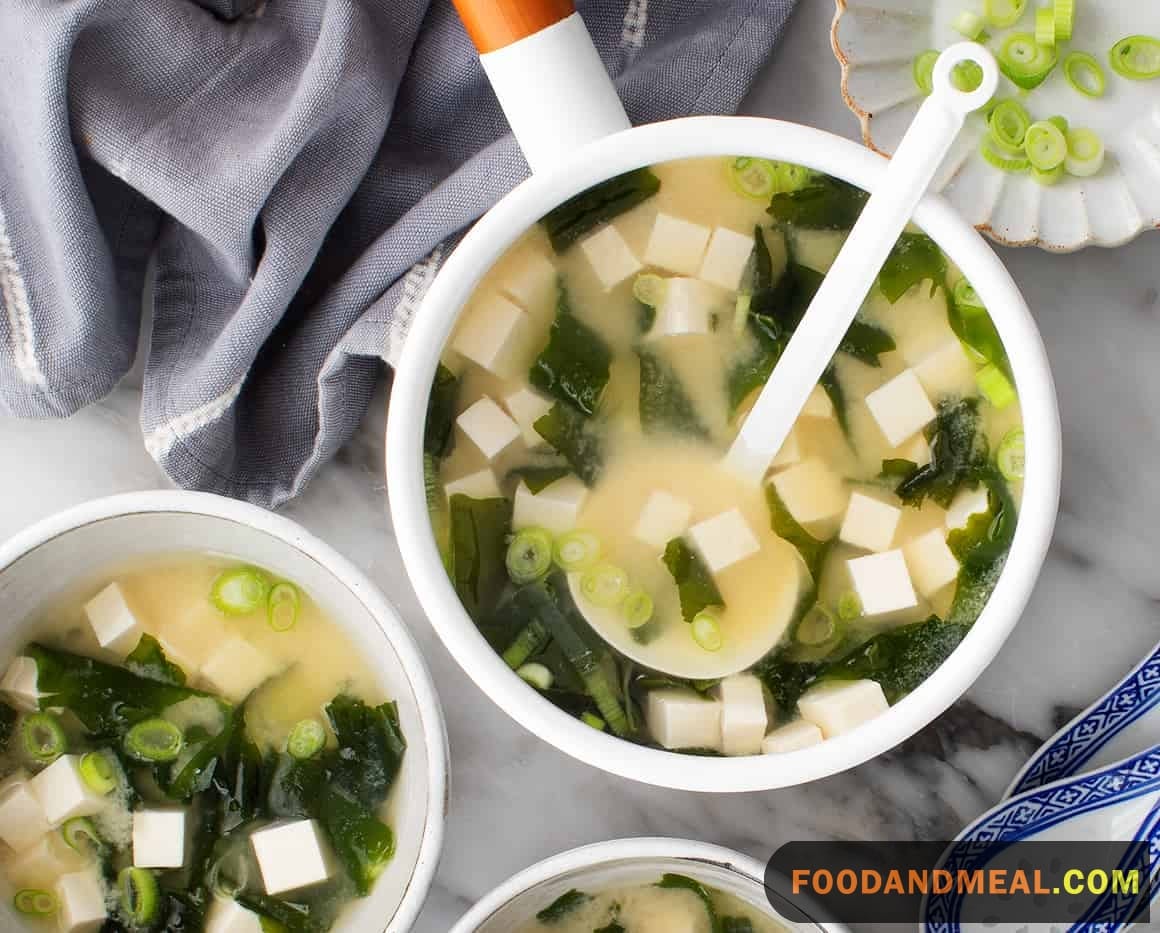
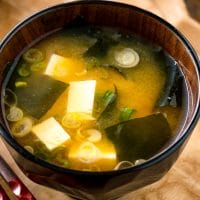
Miso Soup
Ingredients
- 4 cups dashi stock you may also use granules, following the packaging instructions
- 3-4 tablespoons miso paste preferably yellow (but white or red may be used)
- 1 cup firm tofu diced and drained on towels
- 2 green onions cut into ½-inch pieces
Instructions
- Heat the dashi stock in a pot or saucepan, and bring it to a boil. Reduce heat.

- Put the miso in a strainer, and submerge it in the boiling stock. Press the miso through the sieve into the stock.

- Add the tofu and green onions.

- Simmer about 3 minutes, and serve.

Video
Notes
Nutrition
© Food And Meal
This website provides approximate nutrition information for convenience and as a courtesy only. Nutrition data is gathered primarily from the Spoonacular Database, whenever available, or otherwise other online calculators.
How to Make Miso Soup Without Tofu
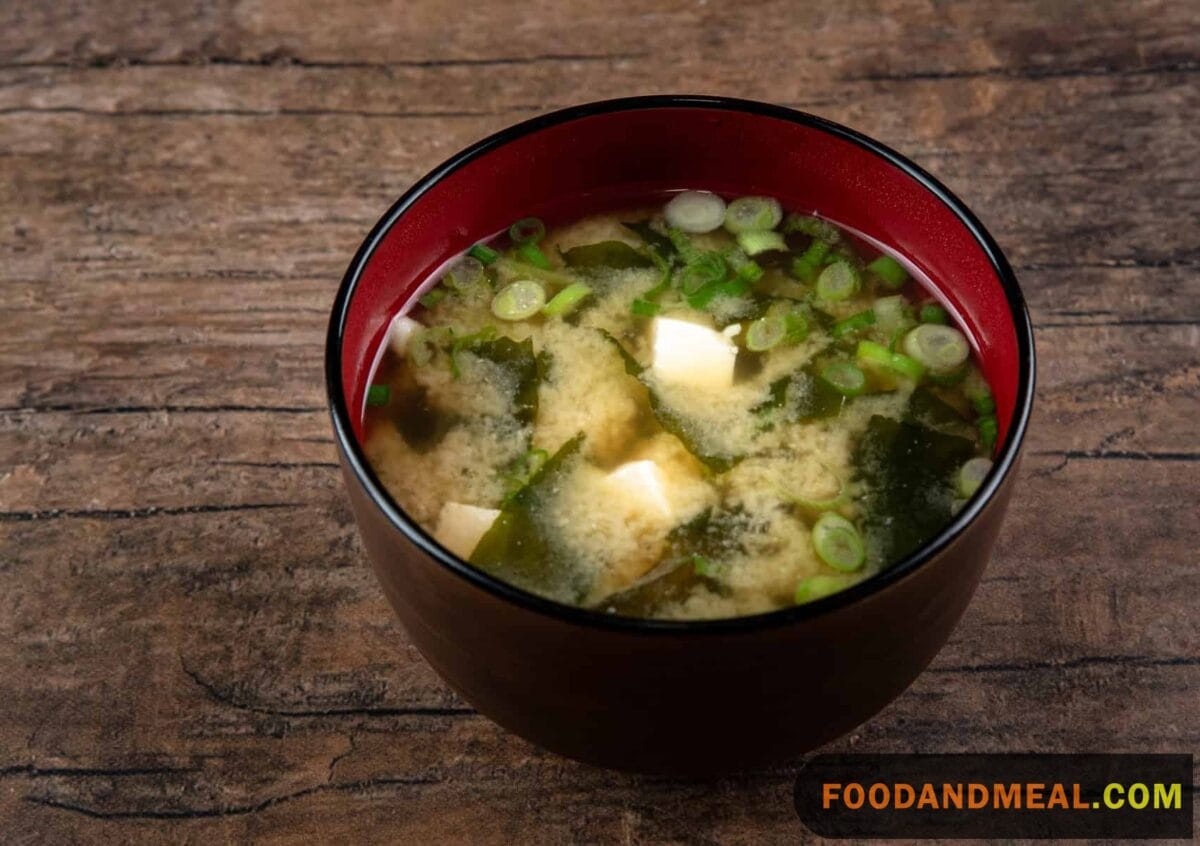
As someone who avoids soy, I used to think miso soup was off limits for me. But after some experimentation in the kitchen, I discovered you can make a hearty, flavorful miso broth without tofu. The key is loading it up with lots of vegetables, mushrooms, and seaweed.
I prefer making miso soup in the fall and winter when root vegetables are in season. Carrots, daikon radish, potatoes, and kabocha squash all work nicely. You can also use leafy greens like spinach or bok choy. Shiitake mushrooms lend an earthy, umami flavor that makes you forget about the missing tofu. And don’t forget the seaweed – it provides that quintessential briny note.
My favorite miso soup recipe uses dashi stock made from kombu (kelp) and bonito flakes as the base. I sauté carrots, shiitakes, and chopped greens in sesame oil before adding the dashi and miso paste. Garnished with scallions and wakame seaweed, it’s deeply satisfying. The broth is packed with flavor even without a block of tofu.
Vegan miso soup recipe without dashi
I recently tried making miso soup without dashi stock, using vegetable broth as the base instead. While not completely traditional, it turned out surprisingly tasty! The key is whisking the miso paste into hot broth off heat to avoid overcooking the miso. I added soft tofu, chopped kale, and green onions for texture and extra nutrients. The flavors blended together into a light, savory soup that felt healthy yet comforting. While dashi does provide an extra layer of umami, this quick weeknight version hit the spot. The greens and tofu made it feel fresh and nourishing. I’ll definitely keep this meatless miso recipe in mind next time I want something warm and soothing without too much effort. It came together fast but was still full of flavor. For an easy homemade soup, I was pleasantly surprised by the results!
Expert Tips for making Miso Soup
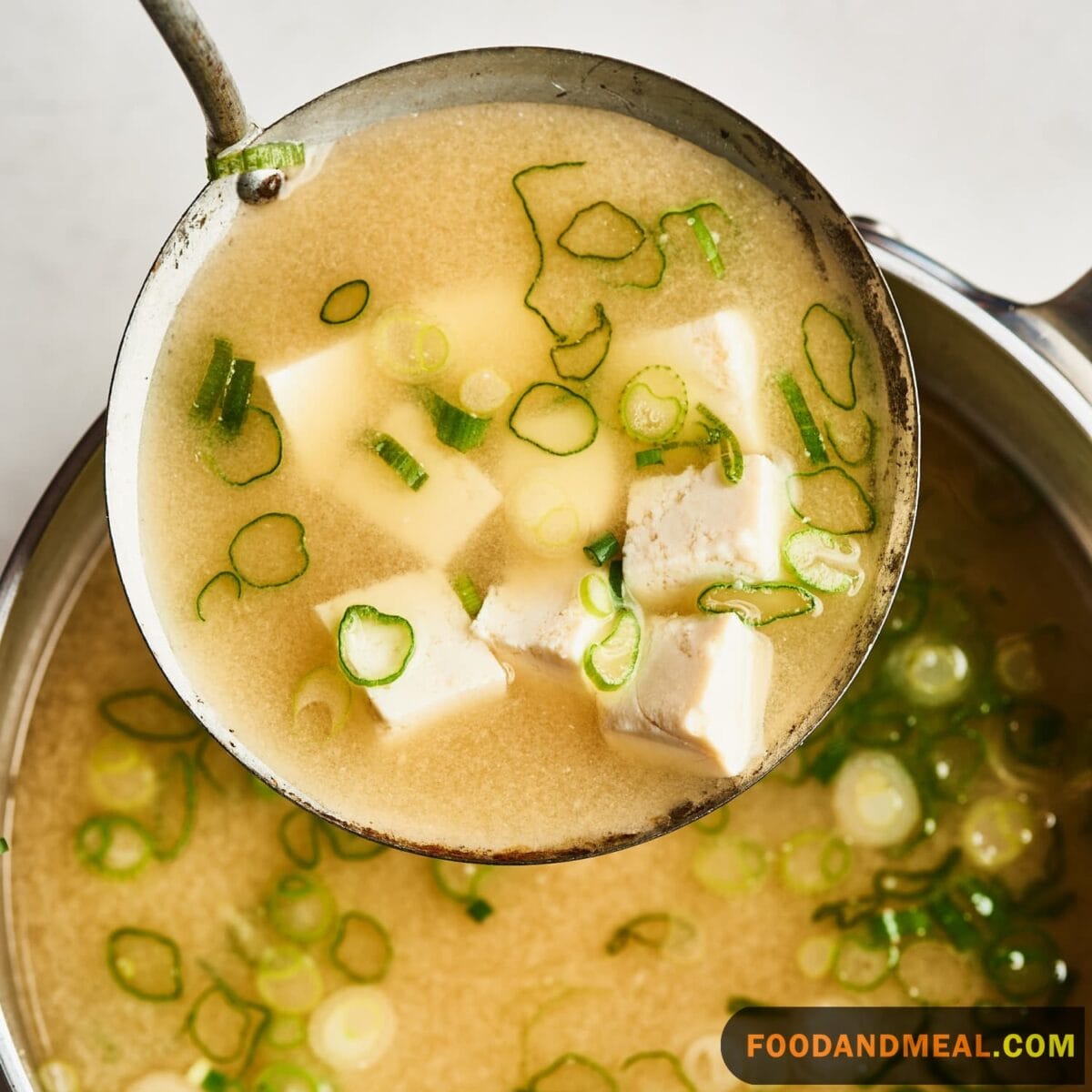
What to eat with miso soup ?
Miso Soup goes well with many classic Japanese dishes like gyoza, sashimi, and karaage. The light, savory broth is the perfect complement to crispy and tender textures. I’d suggest starting your meal with a small bowl of miso to whet your appetite.
For the main course, miso pairs nicely with rice bowls like oyakodon or donburi topped with sweet and salty glazed meat or seafood. The umami from the miso will enhance the rich flavors of chashu pork or chicken katsu. Fried items like tempura or korokke croquettes also stand up well to the hearty soup.
Additionally, serving miso alongside noodles is a common combination. Try it with yakisoba, ramen, or udon for a warming and comforting meal. The noodles soak up the tasty broth.
I’d steer clear of sweeter dishes like daifuku mochi or anko pastes as the flavors would clash. But for many classic savory Japanese recipes, starting with or incorporating miso can perfectly tie the meal together. This simple soup truly brings out the best in many dishes.
Cooking tips
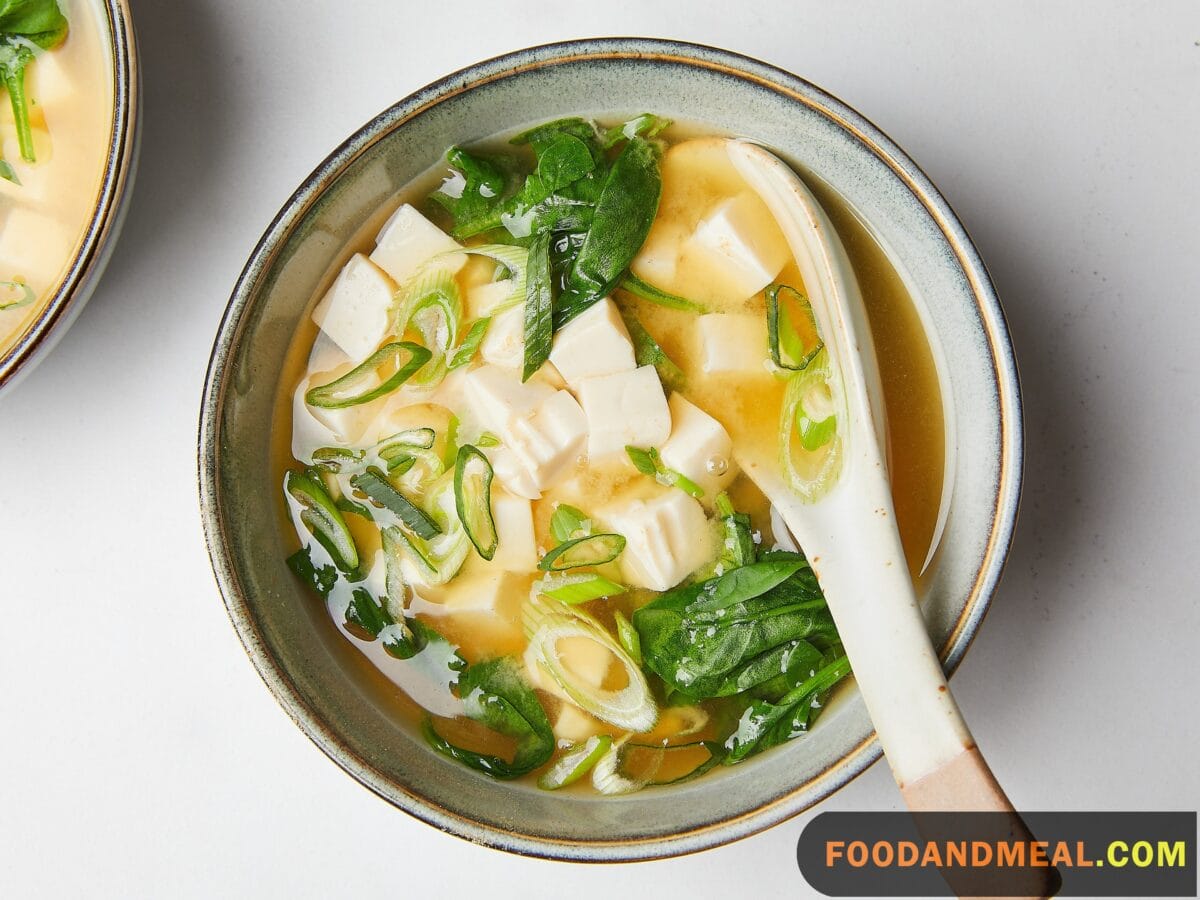
When making miso soup at home, I’ve learned a few tips over the years. The key is patience – take your time to slowly extract flavors from the kombu seaweed and allow the bonito flakes to infuse the broth. Rushing the process or boiling the soup ruins the delicate flavors. I also recommend making dashi stock in advance and keeping it refrigerated or frozen. This allows you to whip up a bowl of miso soup anytime.
My favorite part is dissolving the miso paste into the hot broth. I like to use a ladle to prevent over-mixing. Then comes the fun of adding toppings like soft tofu, tender wakame seaweed, or seasonal vegetables. Their textures and colors make the bowl even more appetizing.
FAQs about Miso Soup recipe

1. What is real miso soup made of?
Miso soup typically consists of dashi (a broth made from kombu seaweed and bonito flakes), miso paste (fermented soybean paste), and ingredients such as tofu, seaweed, and green onions.
2. Is drinking miso soup healthy?
Yes, miso soup can be a healthy option. Miso is rich in probiotics and nutrients, and the soup often contains vegetables and tofu, adding to its nutritional value. However, the overall healthiness depends on the specific ingredients used.
3. What is miso?
Miso is a traditional Japanese seasoning produced by fermenting soybeans with salt and koji (a type of fungus). The result is a thick paste with a unique umami flavor, widely used in Japanese cuisine.
4. Is miso good for gut health?
Yes, miso can be beneficial for gut health due to its probiotic content. The fermentation process involved in making miso promotes the growth of beneficial bacteria, which can contribute to a healthy digestive system.
5. Can I store leftover Miso Soup?
Absolutely! Store any leftover Miso Soup in an airtight container in the refrigerator. It can be kept for up to 2-3 days. Reheat it on the stovetop, but avoid boiling to preserve the delicate flavors.
6. What’s the difference between white and red miso paste?
White miso paste is milder and sweeter, while red miso paste is richer and saltier. The choice between the two depends on your preference for the soup’s flavor.
7. How can I adjust the saltiness of Miso Soup?
To make your Miso Soup less salty, simply dilute it with more water or broth. If you want it saltier, add a bit more miso paste gradually until it reaches your desired level.
8. Can I make Miso Soup without tofu?
Certainly! If you’re not a fan of tofu, feel free to omit it or replace it with cooked chicken, shrimp, or more vegetables.
9. Can I use any type of seaweed for garnish?
Yes, various types of seaweed can be used for garnish. Nori is common, but you can also try wakame, dulse, or hijiki for different textures and flavors.
Conclution
I hope this miso soup recipe brings you warmth and comfort. The preparation process can have a meditative, soothing effect as you chop, measure, and watch the ingredients meld into a restorative broth. Savor the umami flavors and let the memories and connections this dish brings nourish your spirit.
If you enjoyed this recipe, be sure to explore the many other comforting dishes from around the world on Food And Meal. Our website features culinary creations that feed both body and soul. Wishing you many hearty, wholesome meals that provide the sustenance you need to thrive.
I'm James F Anderson, a noted sous chef from London and a Le Cordon Bleu alumnus. My career began in a Michelin-starred Parisian eatery, where my blend of classic and contemporary cooking, using seasonal ingredients, earned accolades. Recognized in culinary publications and on cooking shows, I’m committed to mentoring aspiring chefs and delivering memorable dining experiences, marking me as a standout talent in the culinary world.






